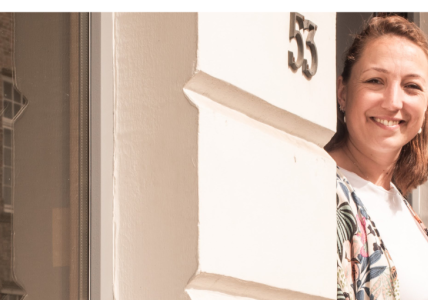A future without bees? Why we need to act now and what can be done. BEESPOKE has left a solid legacy behind, ready for farmers and policymakers to pick up.
Looking across a northern European agricultural landscape in summer is typically a sea of green. Productive maybe, but with few flowers and therefore few bees. Unfortunately this is having an impact and wild bees are declining in agricultural areas.
So what would life be like without pollinating insects?
Our diet would be extremely bland, consisting mostly of grains with very few fruits, berries, nuts and vegetables that also provide essential micronutrients. In fact, most items needed to maintain a healthy diet.
In the BEESPOKE project we set out to find new solutions and incentives to support wild pollinators so that we can future-proof our food production.
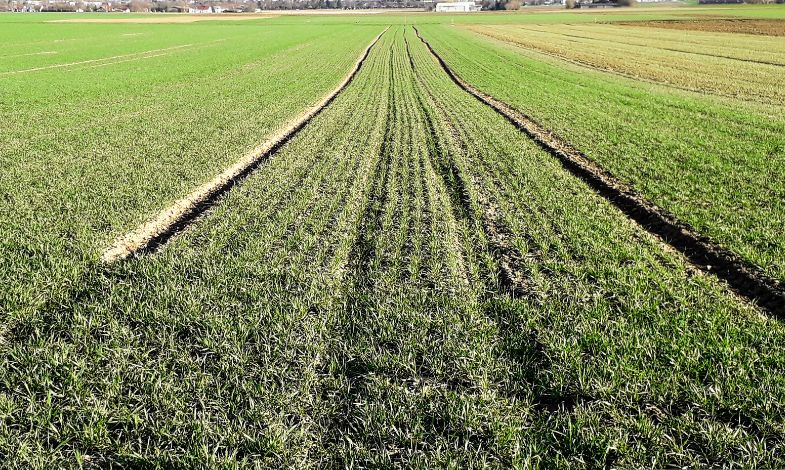
Agricultural fields do not always offer many flowers for pollinating insects to thrive. Photo: Alfred Tei/Getty images via Canva.com.
Why farmers need wild bees
For many years, land managers in the North Sea Region have had access to agri-environment funds. In theory, they could use these funds to create flower-rich habitats for wild bees.
However, not many take up these options and when doing so the aim is to help conservation rather than crop pollination. This is understandable if the farmers don’t grow insect-pollinated crops. However, even a mostly wind-pollinated crop such as oilseed rape can sometimes benefit from insect pollination. For fruit growers, the benefits of pollination can be more substantial, improving both yield and quality.
The problem is that pollination is rarely measured. Also, maximising crop pollination requires knowledge because the types of pollinators needed differ between crops.For example, solitary bees are better at pollinating apples whereas beans need bumblebees.
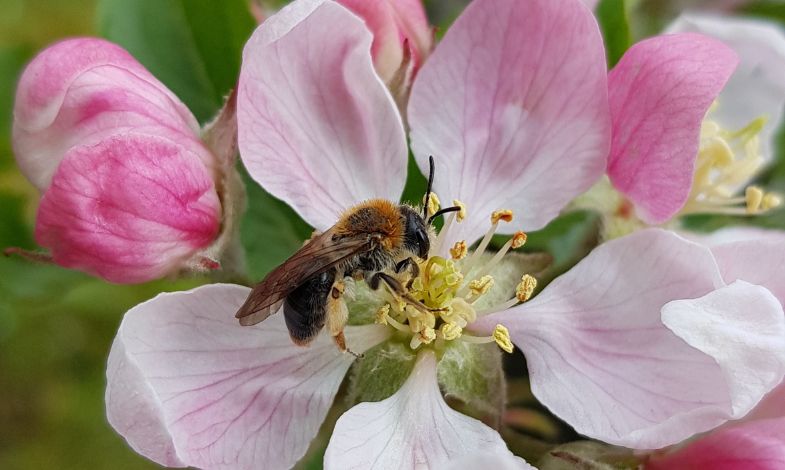
A solitary bee (Andrena haemorrhoa) in an apple blossom. Image: Konstantinos Tsiolis/BEESPOKE.
Sowing the seeds of knowledge
In BEESPOKE, we made a strong effort to bridge the gap between science on the one side and farming policies and practices on the other. We therefore took an interdisciplinary approach to boosting wild pollinators.
We developed a range of tools and tips. This included 21 guides and 33 videos encouraging stakeholders to adopt pollinator-friendly practices and policies.
We also encouraged sharing of best practices and new solutions based on our research on pollinator conservation. BEESPOKE reached around 400,000 people via digital platforms, field demonstrations, training materials and events, demonstrating the far-reaching interest in pollinators.
The BEESPOKE project has enabled us to share information between colleagues in the North Sea Region, help farmers to improve habitats for pollinating insects and furthered our understanding on the vital role insects play in crop production.
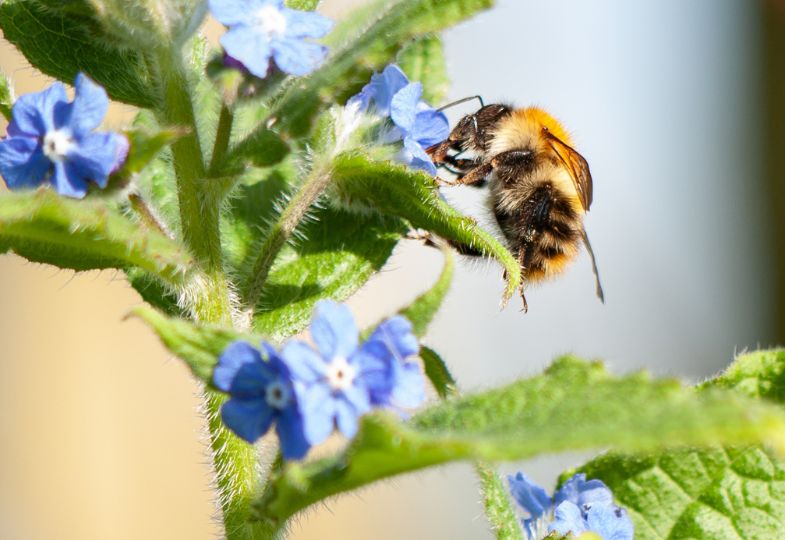
How to measure crop pollination
We may be slow to detect a decline in crop pollination as it is not routinely measured. To help in the process, NIAB East Malling (UK), University of Copenhagen and Horticultural Advice A/S (Denmark) developed farmer and grower user guides and videos on how to measure pollination of six crops: Apple, pear, cherry, strawberry, blackcurrant and raspberry.
We also produced guides on how to identify the main crop pollinators, including bumblebees and solitary bees and measure overall levels of pollinators.
Wildflowers for key crop pollinators
To support the specific types of pollinators needed by different crops, we designed novel wildflower seed mixes for eight crops which benefit from insect pollination: Apple, pear, strawberry, sweet cherry, raspberry, blackcurrant, oilseed rape, and broad bean.
The flower mixes provide the types of native flowers that would attract the crops' most important pollinators while not supporting their pests.
Within the project, the mixes were attractive to a wide array of pollinators, other beneficial insects and overall biodiversity and in some situations helped improve crop quality. Insects that help control crop pests were also often abundant in the wildflower mixes demonstrating that they have additional benefits for crop production.
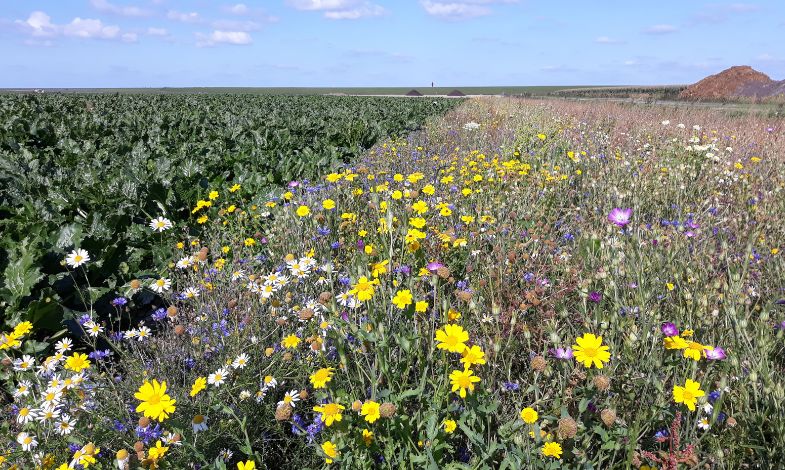
BEESPOKE flower strip. Wildflower mix designed by Cruydt-Hoeck seed company for farmers in the Agricultural Collective Waadrâne in Fryslan, the Netherlands. Image: Henk-Jan van der Veen.
Establishing and managing wildflower areas has many challenges, so we produced guides and videos on that topic, including avoiding common mistakes. The partners also provided training to help land managers ensure quality habitats. Over 300 new wildflower areas were created through BEESPOKE.
Selecting the most appropriate wildflower seed mix for a locality is crucial. Factors such as soil type and shade can be highly influential on which species will thrive. Seed merchants can provide such advice but may not know which plant species are best for the pollinators. To help, we created a database of plants used by pollinators and an online seed selection tool.
We hope that farmers and growers will begin to develop their own mixes based on the information BEESPOKE has provided, tailored to their soil and environmental conditions and target crop.
Enhancing grasslands for wild bees
Intensively managed grassland covers much of Northwest Europe. It is comprised primarily of rye grass providing little for pollinators.
A new grassland seed mix was therefore developed by the University of Oldenburg and by Cruydt-Hoeck/Van Hall Larenstein, University of Applied Sciences. This contained herbaceous flowering plants that not only support bees but provide nutritious forage for livestock, especially in dry summers. The five farmers in Germany involved in testing this will continue using the mix which the seed company has also sold to over 100 farms.
On June 19, 2023, a webinar was held all about herb-rich grasslands for livestock. Participants learned about the value of reestablishing diverse grasslands, their benefits for pollinators, biodiversity, and farmers.
Other non-crop habitats found on farmland such as hedgerows, woodland, field margins and other agri-environment scheme habitats can also provide floral resources and nesting sites for wild bees.
Arable plants (weeds) within crops and in scruffy areas are also important for bees. We found that farming approaches, such as regenerative farming, which include more floral areas also benefit pollinators and pollination of wild plants.
We compiled recommendations on how to best manage such habitats or to just leave alone.
Influencing policymakers
Very little information was available regarding farmer attitudes to pollinators and crop pollination. This is why we carried out surveys of the attitudes and experiences of land managers across the North Sea Region.
This study revealed the constraints and issues that the farmers face when utilising agri-environment schemes including the barriers that prevented some from entering the schemes in the first place. We also appraised existing agri-environment schemes in each country, to determine how well they were delivering for pollinators and how they may be improved.
Armed with this information and the knowledge accrued by all the partners, we were able to produce a set of policy recommendations. We presented them to key policymakers at our final symposium in Brussels and shared them with national organisations developing agri-environment schemes.
Our partner VLM is the managing authority for agri-environmental measures (AEM) in Flanders. VLM ensured our recommendations were considered in the design of the AEM in the new EU Common Agricultural Policy (CAP) 2023-2027 in Flanders. In Denmark, there is a now a new subsidy in place for farmers to create wildlife habitats below one hectare, such as perennial wildflower areas.
New tools for land managers
The North Sea Region is intensively farmed and consequently new habitats for pollinators need to be established on farmed land. Agri-environment schemes are one mechanism that can be used to establish these habitats.
This can be an attractive option on low-yielding lands, but not always. Economic investigations revealed that the opportunity costs - i.e., from producing a crop - determine whether agri-environment options are more profitable rather than the costs associated with establishing and managing the habitat.
For highly pollinator-dependent crops, increasing pollinator habitat may be a necessity when pollination levels are low. In such situations, the landowners need to know how much land to take out of production and where to place habitat for pollinators to optimise wild bee conservation and crop pollination - or whether this needs to be done at landscape scales.
In addition, as wild bees can be quite mobile there may be opportunities for land managers to work together at a landscape scale to support wild bee populations. To help with this, the BEESPOKE project has developed two online tools:
Tool 1 allows users to assess freely available pollination services from existing habitats for a range of crops. It can also predict the effect of adding flower strips or nesting places on crop pollination. Predictions are available for Belgium, Denmark, Germany, Netherlands, Norway, Sweden and the UK.
Tool 2 offers country-specific tips on the best flowering species for 12 crop types. We identified the main pollinators of each crop along with the three top plant species on which they forage, excluding any that may attract pests The tips cover Belgium, Denmark, France, Germany, Netherlands, Norway, Poland, Sweden and the UK.
A third tool provides monitoring data from Belgium and scores how well the BEESPOKE flower mixtures for Flemish landscapes support crop pollinators and/or rare bee You can find it here.
A legacy built together
By working across borders, we were able to share our experiences of habitat conservation for pollinators. We found major differences in different countries' use of agri-environment measures to conserve pollinators and other insects. And testing new seed mixes across several countries enabled us to develop more robust approaches to pollinator conservation in the North Sea Region.
The BEESPOKE project laid the ground for further action and leaving a tangible legacy of tools and new actions to act upon, based on our work.
- The BEESPOKE outputs will remain available as an important source of information on crop pollination and pollinator conservation. Partners and other stakeholders will continue using and promoting them as a ”go to” toolbox.
- The University of Ghent will continue to maintain and improve the two online tools.
- The interest is clearly there; partners continue receiving requests for help regarding seed mixes to plant in and around their crops.
- Many wildflower areas established during the project will remain, helping to conserve pollinators and provide a valuable resource for future projects. Also, there are already plans for follow-on projects.
The right time for action is now
The worldwide decline in insects has attracted considerable media attention over the last five years. Yet, most land managers are not concerned about pollination levels, partly because this is not routinely measured.
We provided a set of simple methods for land managers to monitor pollination and estimate it for their locality.
Our project revealed the challenges of establishing and managing new wildflower areas. To create high-quality habitats, managers need flexibility and training alongside financial support, but without too much bureaucracy.
Agricultural landscapes must deliver a greater abundance and diversity of flowering plants, trees and nesting habitat to prevent further decline in pollinators. This is our key message to all land managers and policymakers.
Top 3 project highlights
Guidance for farmers
BEESPOKE created a wide range of training materials on how to encourage pollinators and measure crop pollination. Two online tools help land managers assess pollination by wild bees, predict the effect of adding extra habitats and choose the best flower mix to enhance pollinators for 12 crop types.
Policy inputs
Through feedback from stakeholders and project activities, the project compiled and publicised a set of policy recommendations to encourage pollinators.
300 new flower plots
BEESPOKE created over 300 new flower plots, demonstrating the benefits of bespoke wildflower seed mixes for wild bees and the crops they pollinate.
Learn more
To learn more, visit the project's website:
Access the project's extensive range of training materials and download their free guides:
BEESPOKE tools and publications
Gain insights into how policy can enhance conditions for pollinators in farmlands:
BEESPOKE policy recommendations
Access training and explainer videos:
To learn more about the project results see the projects two online magazines:
To get a good overview of the topics covered by BEESPOKE, explore the magazine below:
Get in touch
Contact the project coordinator at beespokensrproject@gmail.com
Contact the project communication manager at jw@vankruyssen.eu
About the author
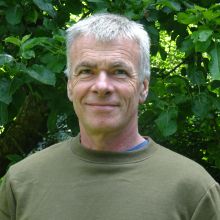
Professor John Holland led the BEESPOKE project. He is now a freelance agricultural entomologist who has been investigating ways to support pollinators on farmland for 20 years.
